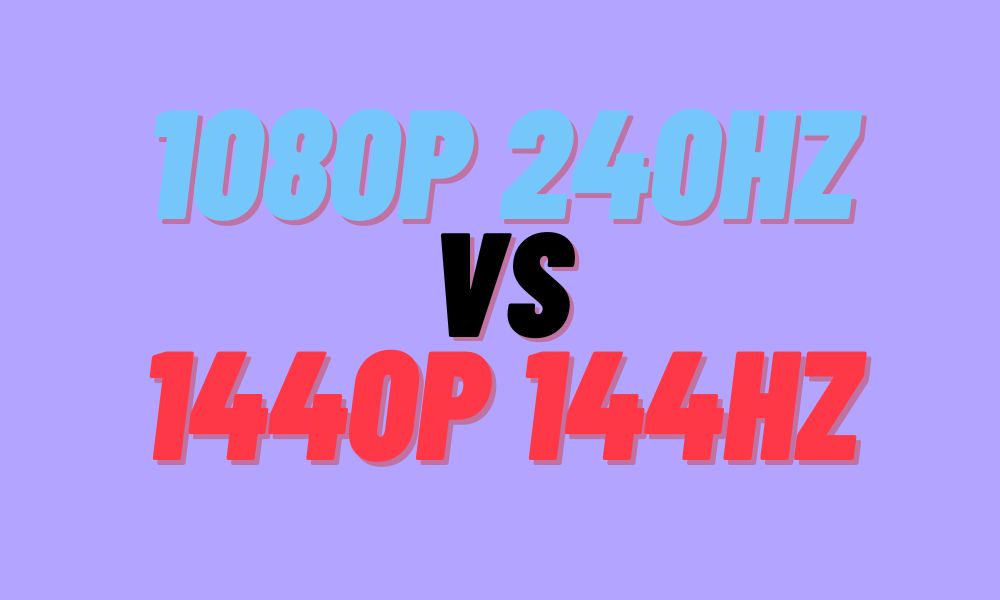With the constant advancement in gaming monitor technology, gamers now have more options when it comes to display resolution and refresh rates. Two of the most popular combinations currently are 1080p at 240Hz and 1440p at 144Hz. But which one is better for gaming? Here is a detailed comparison between the two to help you decide.
1080p 240hz vs 1440p 144hz
Here is a comparison table summarizing the key differences between 1080p 240Hz and 1440p 144Hz gaming monitors:
| Specs | 1080p 240Hz | 1440p 144Hz |
|---|---|---|
| Resolution | 1920 x 1080 | 2560 x 1440 |
| Pixel Count | 2.1 million | 3.7 million |
| Aspect Ratio | 16:9 | 16:9 |
| Refresh Rate | 240Hz | 144Hz |
| Motion Clarity | Extremely smooth | Very smooth |
| Pixel Density | Lower | Higher |
| Image Quality | Good | Great |
| Graphics Card Need | High-end | Mid-range to high-end |
| Game Genres Best For | Competitive esports | Cinematic & mixed gaming |
| Screen Size | 24 to 27 inches | 27 inches or larger |
| Price | $300 – $500 | $400 – $700 |
Resolution
The most obvious difference between 1080p and 1440p is the resolution. 1080p refers to a resolution of 1920 x 1080 pixels. 1440p, also known as Quad HD or QHD, has a resolution of 2560 x 1440 pixels. This results in 1440p having around 1.77 times more pixels than 1080p. The higher resolution of 1440p leads to sharper and more detailed visuals. Individual pixels are harder to discern and everything looks more crisp and life-like. This enhanced visual fidelity improves immersion in games.
However, the higher resolution also means the GPU has to work harder to render frames at 1440p versus 1080p. So gaming at 1440p requires a more powerful graphics card to maintain high frame rates compared to 1080p.
Refresh Rate
Both 1080p 240Hz and 1440p 144Hz monitors have high refresh rates. A 240Hz refresh rate means the monitor can refresh the display up to 240 times per second. Similarly, a 144Hz refresh rate equates to 144 refreshes per second.
The higher the refresh rate, the smoother and more fluid motion will look in games. 240Hz makes gameplay extremely smooth and responsive, reducing motion blur significantly. It’s why competitive esports gamers favor 1080p 240Hz monitors currently.
But 144Hz is still a big upgrade over standard 60Hz monitors. Motion clarity and responsiveness get a sizable boost at 144Hz compared to 60Hz. While not as fast as 240Hz, high frame rate gaming at 1440p on a 144Hz monitor still looks and feels very smooth.
So for refresh rates, 1080p 240Hz wins out. But 1440p 144Hz still provides a excellent experience.
Performance Requirements
To take full advantage of these monitors requires some serious hardware. Ideally you want your frame rates to match the monitor’s refresh rate. This prevents screen tearing and provides the smoothest experience.
For 1080p 240Hz, you need a powerful GPU capable of pushing frames between 200-240fps consistently in the games you play. Examples include the RTX 3070 Ti or RX 6800 XT. This requires lowering some settings in more demanding games.
1440p 144Hz is more achievable with mid-range to high-end GPUs like the RTX 3060 Ti or RX 6700 XT. You can typically hit 100-144fps at 1440p in most games by adjusting a few settings. This mid-range hardware makes 1440p 144Hz a bit more accessible currently.
Competitive vs Cinematic
Gaming Another factor is the type of games you play. Fast paced competitive titles like CS:GO, Valorant, and Fortnite benefit greatly from 1080p 240Hz. The lightning quick reflexes and crystal clear motion give a real advantage in these games. The lower resolution isn’t as noticeable when focusing on quickly reacting during action packed moments.
For slower paced story-driven games, 1440p 144Hz allows you to better appreciate cinematic graphics and environments. Games like Assassin’s Creed, Red Dead Redemption 2, and Cyberpunk 2077 look stunning at 1440p while still performing smoothly at over 100fps.
If you play a healthy mix of both competitive and cinematic games, 1440p 144Hz provides the best blend between high resolution and fast refresh rates.
Conclusion
While 1080p 240Hz provides extremely smooth motion clarity, the low resolution is starting to show its age in 2023. 1440p 144Hz monitors take advantage of improved modern GPU power to offer the pixel density of 1440p while still maintaining high frame rates.
For most gamers, we recommend 1440p 144Hz as the better all-around choice. But 1080p 240Hz monitors still excel for competitive esports. Ultimately, choose the monitor that best fits your gaming needs and hardware capabilities. Both are great options that will take your gaming experience to the next level.
